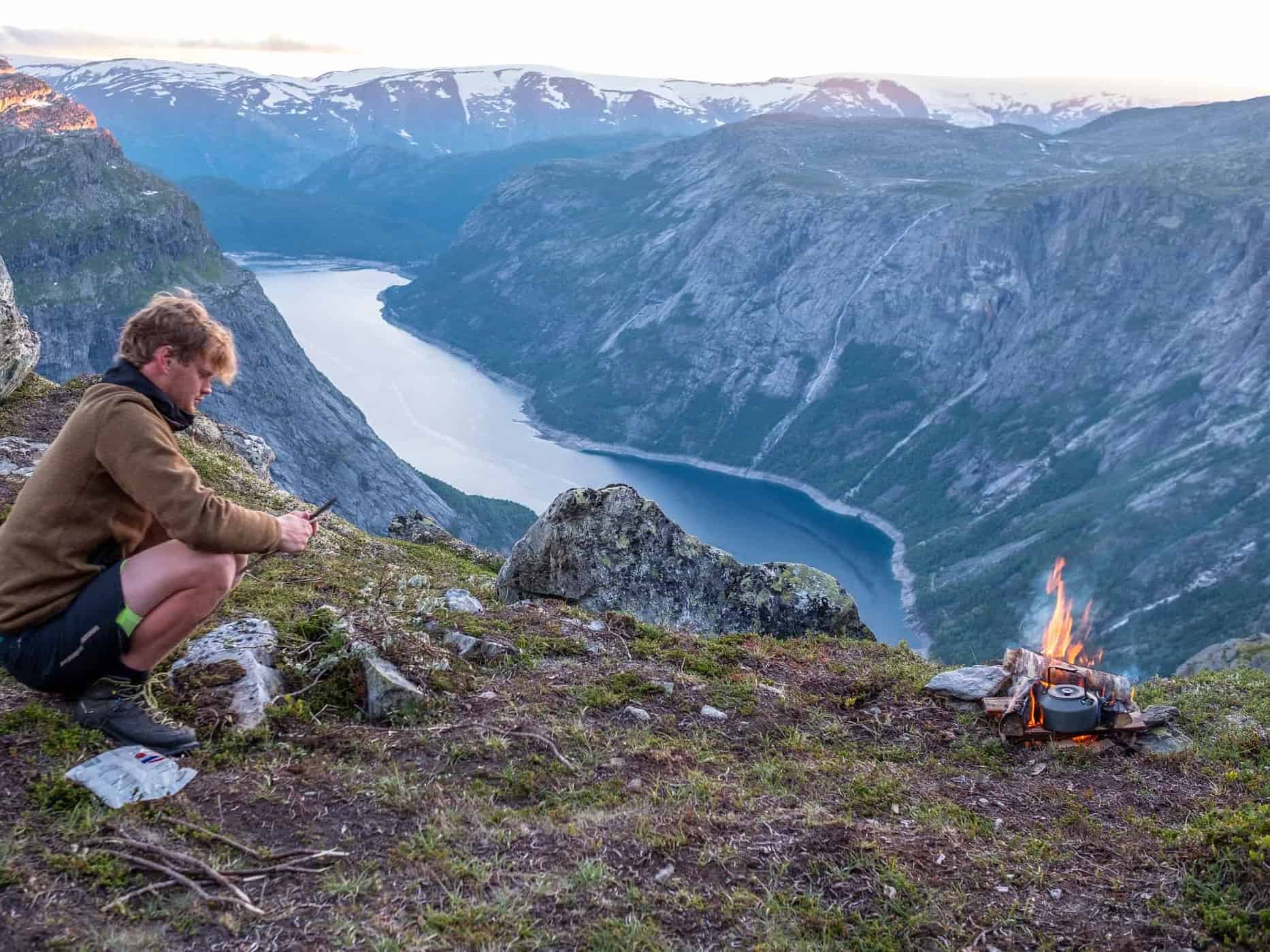Last updated on February 9th, 2023 at 05:35 pm
Imagine. You’ve been hiking all day. You’re wet, cold, hungry, and tired. You’re desperate for a fire, but everything around you is soaked. Knowing how to start a campfire with wet wood is an essential skill for any outdoor adventurer.
Starting a campfire with wet wood means knowing where to find the best wood, how break it down, and build a sustainable fire. Make sure you know how.
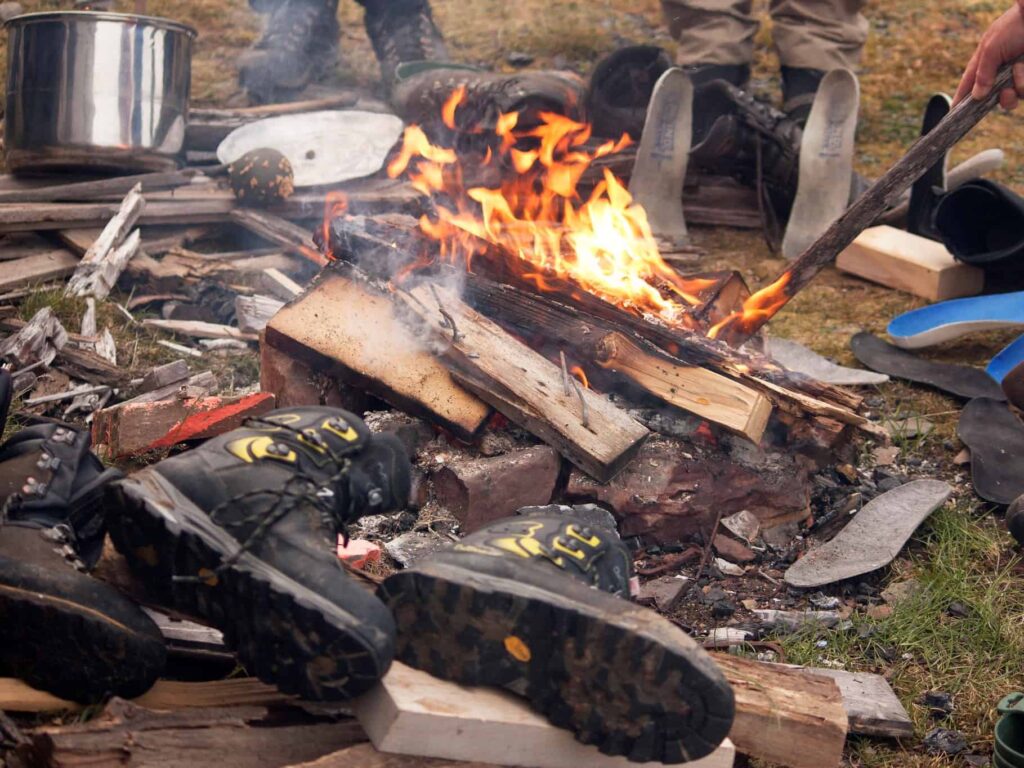
1. Gather Combustibles
Firstly, finding dry kindling, tinder, and fuel is certainly no easy task in the rain.
For instance, tinder lights quickly, but it doesn’t stay lit long. Kindling is a little larger and burns longer, but doesn’t light as easy. And, fuel are the largest logs that keep feeding your fire.
In wooded areas, all are certainly much more accessible.
Where to search:
- around the base of trees
- dead limbs up in the tree canopy
- under the dry side of trees
- dig through the soaked foliage beneath trees to unearth drier wood
However, if you’re in an area where trees aren’t readily available, your task is more challenging.
If you’re in the desert, these plants are great fuel:
- creosote bushes
- saguaros
- palo verde trees
The same concept applies. Just search around the bases to find the driest wood and don’t burn anything green.
Gather Lots of Kindling

Even if you can’t find readily available dry wood, not all is lost. You can still dry wood, but you’ll have to work for it.
Hopefully, you remembered to pack a knife, foldable saw, or hatchet.
Wood doesn’t absorb water like a sponge, so even if the outside is wet, the inside will still be dry.
In fact, cut away the outer pieces of your wood to expose the dry stuff in the middle. Then, collect as much tinder and kindling as possible.
Additionally, if it’s still raining, you’ll have to figure out a way to keep it dry while you continue working. Plus, understand that you need substantially more wood for wet fire conditions.
In fact, wet wood fires require almost four times as much fuel, so don’t skimp on your collection.
Finally, if it’s important to get a fire started for dinner, consider bringing a camping stove along. They can help get the crew fed faster so you have more energy to chop and strip wood. For all of our favorite camping stoves, take a look at our Best Camping Stove post.
2. Gather Tinder
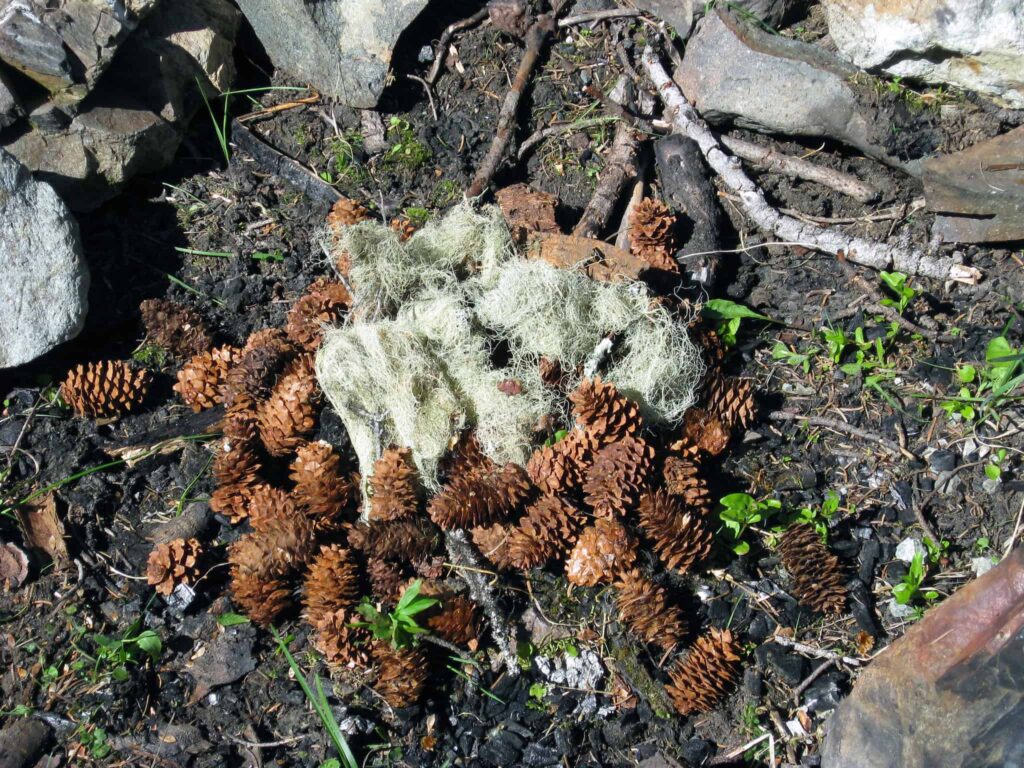
In addition, you’ll need good dry tinder. We always carry some in our fire starting kit, and you should too.
Tinder is lightweight and compact so it doesn’t take up a lot of room. In dire situations, it can really be a lifesaver.
Tinder should be small and able to catch fire quickly.
If you need some on the fly in your environment, search around conifer trees, as anything coated with sap burns well.
Additionally, there are all sorts of go-to DIY fire starters that survivalists swear by. Plus, there is an abundance of commercial products available as well.
Popular DIY options include:
- Drier lint mixed with wax
- Sawdust, shavings, and wood chips mixed with wax
- Toilet paper tubes stuffed with paper
- Pine cones dipped in wax
- Cotton balls soaked in petroleum jelly
Gather Your Fuel Wood
Finally, gather the driest wood you can find. Remember, you’ll require more because the wood is wet.
Softer woods, like evergreens, will burn hotter, but also faster.
Additionally, if you’ve got a good knife, you can split smaller logs to access the dry wood inside.
And, if you can, get a wide variety of sizes and get a lot. Furthermore, it’s always a good idea to have extra tinder and kindling too.
Then, pile any excess wood by your fire to help dry it out before you throw it into the flame.
Your first attempt may not be successful, and you may have to relight it. Having a little extra of everything will prevent you from having to do all this work twice.
3. Lay a Platform
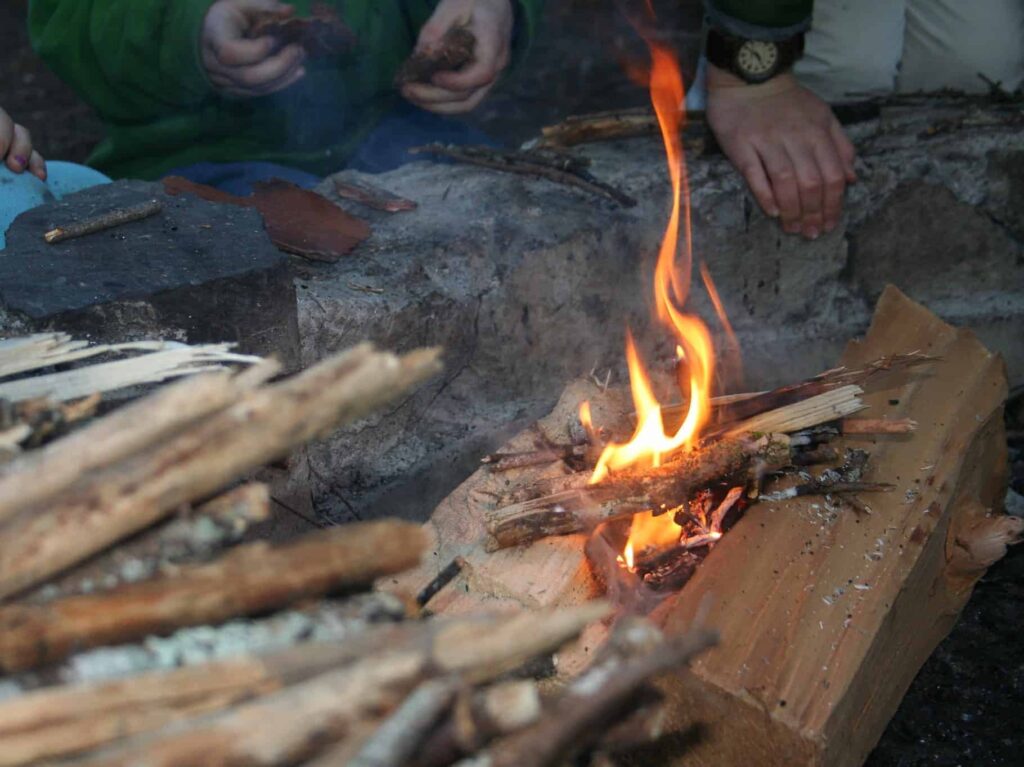
Now, when building a fire in adverse weather conditions, you need to keep three simple variables in mind.
Your fire should be protected from:
- the wind
- any rain or snow
- groundwater
The location of your fire is crucial to its success, so choose wisely.
For instance, start by building a platform to get your fire off the ground. This will also help feed oxygen through the bottom.
You can use rocks or logs to elevate your fire. I prefer rocks if they’re available because when it’s really cold outside, you can take the rocks inside your tent to help stay warm.
Once your foundation is in place, then lay the tinder and kindling on top.
4. Pack Firestarters
Having a firestarter available is essential for any avid outdoorsman.
If you’ve been camping without it, consider upgrading your gear by adding some to your pack.
Firestarter is cheap enough and easy enough to make. In fact, it’s small and compact, so it doesn’t take up much room or add any additional weight.
Plus, it’s a total game changer when the weather turns against you. It’s truly an essential piece of survival gear that every camper should have.
Some of the commercial stuff, like Pyro Putty, is even waterproof and designed to work in wet weather conditions. So you might consider purchasing some just as an added safety measure.
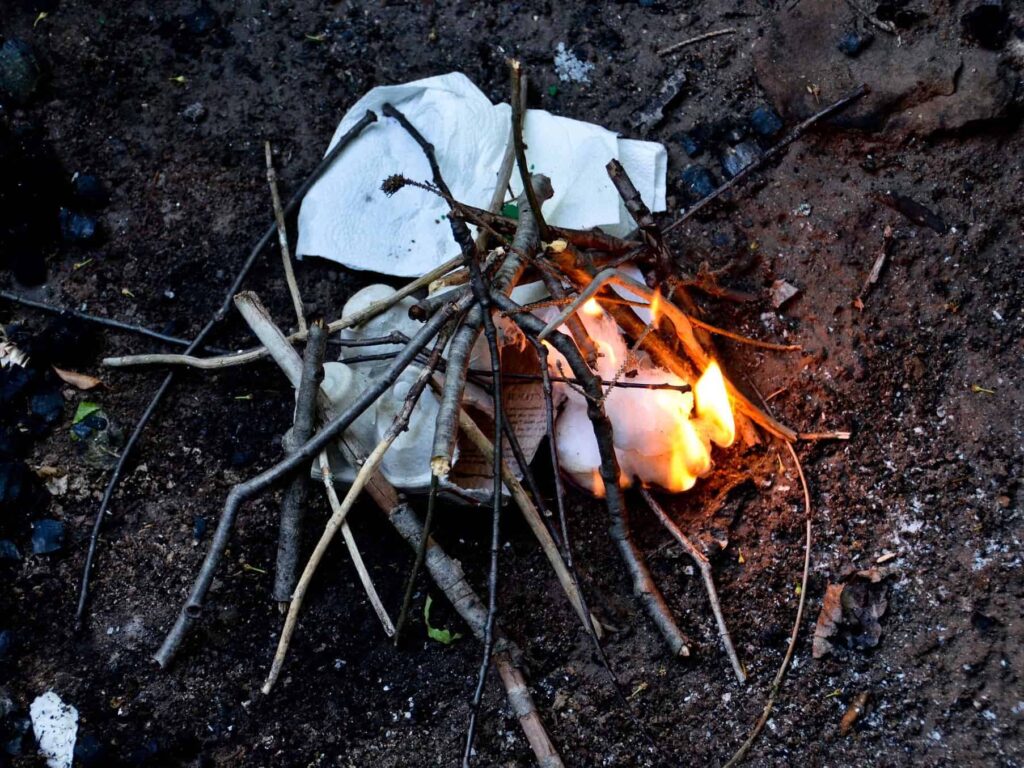
5. Remove Wet Bark
As previously mentioned, you can fin dry wood inside logs and limbs.
For example, with your knife or hatchet, strip your wood of the soaked outer layers to expose the dry wood. Then, you can also split the wood exposing more dry.
However, you’ll need to exercise a great deal of caution here to avoid accidents. You’re working in wet weather. Things slip. Accidents happen. So safety is paramount.
Position the log vertically for optimal safety and skin the log downward with your knife or hatchet. This prevents drawing any blade toward your body.
If you are just fed up with dealing with wet wood, you could always try out a portable fire pit. These setups make getting warm easy, check out our Best Portable Fire Pit post for more benefits.
6. Build Logs in a Pyramid Shape

Next, once you’ve laid your foundation, build your logs into a conical shape over top, leaving an access doorway to place your kindling and tinder inside later.
This helps protect your tinder and kindling from any wind or rain making it easier for you to light.
Additionally, be sure you leave plenty of space between your logs for airflow, which is essential to keep your fire going.
7. Light your Tinder and Kindling First
Now, you’ll place your kindling and tinder inside the structure through your access door.
Add some prepared firestarter, as mentioned above, like toilet paper rolls or cotton balls to the base of your platform. Even spaghetti or corn chips can work if you’re desperate.
Cover your tinder and kindling with a small teepee of thin twigs and sticks that will encourage the larger structure to light, and then light.
Hopefully, you packed a lighter. This is by far the easiest way. Otherwise, matches or even flint and steel are viable options.
Additionally, a pocket bellow is an absolute must for wet fires. If you don’t have one, get one. They are truly lifesavers.
Wet fuel smokes a lot making it hard to light, and therefore requires more oxygen. A pocket bellow is a handy tool. It lets you strategically place oxygen where it’s needed to get your fire going.

8. Stack Spare Wood Near Fire
Finally, lay any extra wood near the fire to help it dry out. Once your fire is going, continue stripping and splitting your remaining logs while staying warm.
As you strip the wet bark, lay it next to the fire as well. The heat helps dry it out, so you may be able to use it in an hour or two. This, of course, depends on how wet your conditions are.
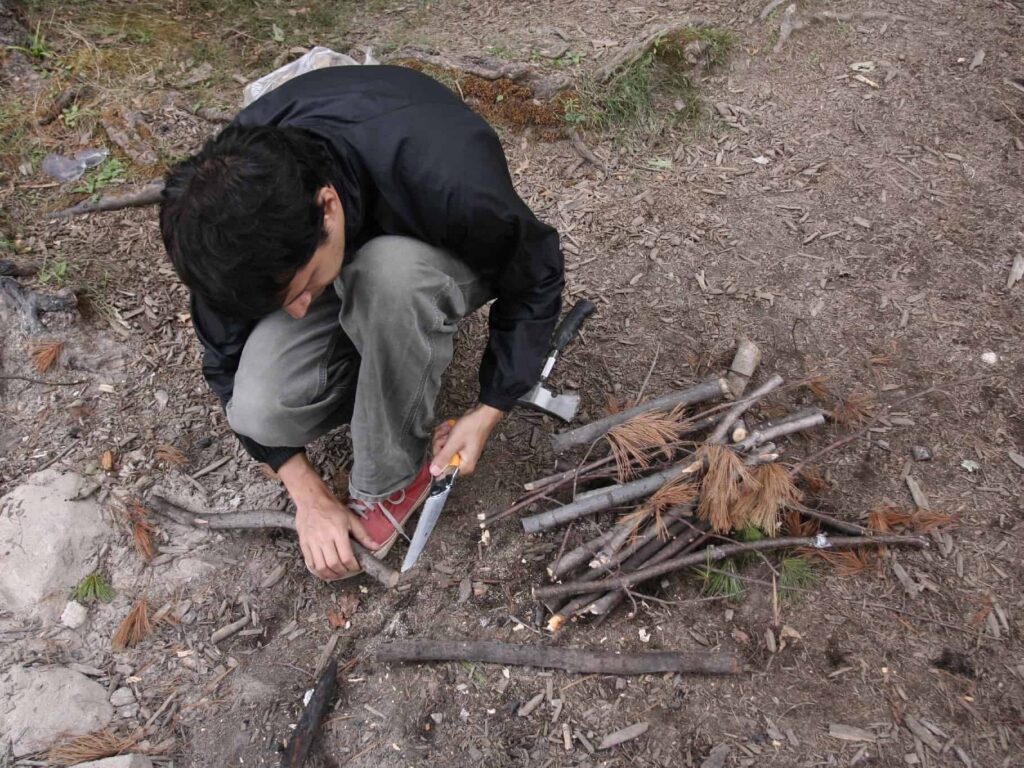
9. Add Wood, Working up by Size
Once your fire is ablaze, gradually add smaller limbs and small logs to your pyramid shape.
Build it slowly and gradually. While it might be tempting to build a large bonfire, resist this temptation.
Keep your fire as small as you can.
Firstly, you can get much closer to a smaller fire than you can a larger one. Secondly, smaller fires allow you to conserve your fuel.
Additionally, conical fires can burn rather quickly, especially if you’re using softwood. Thus, building too large a fire can burn through your wood too fast. And, the last thing you want is to go on another hunt for wood. Finally, if you’re camping in a wet environment, you’ll need a good tent that holds up to keep you safe and dry. Check out our Best Dome Tent for Heavy Rain post to find the perfect one.
10. Warm up After a Wet Hike
It’s always a good idea to practice survival skills at home before heading into the wild. And, creating firestarters to bring is a good start.
However, you can’t always predict the weather on any given hike, so you’re likely going to be caught off guard. With all the above skills under your belt, or at least in your knowledge bank, you’re bound to build a hearty fire on your next camping or backpacking trip. So go out confidently and explore like a survivalist.
About the Author
Sarah Sampsell
Title Image Credit, How To Start A Campfire With Wet Wood: Martyn Smith | (source) | Attribution 2.0 Generic (CC BY 2.0) — reduced file size and image
Image Credit 1, How To Start A Campfire With Wet Wood: Kitty Terwolbeck | (source) | Attribution 2.0 Generic (CC BY 2.0) — reduced file size and image
Image Credit 2, How To Start A Campfire With Wet Wood: Dean (leu) . | (source) | Attribution-ShareAlike 2.0 Generic (CC BY-SA 2.0) — reduced file size and image
How To Start A Campfire With Wet Wood, Image Credit : Ruth Hartnup | (source) | Attribution 2.0 Generic (CC BY 2.0) — reduced file size and image
How To Start A Campfire With Wet Wood, Image Credit : wittco.gmbh | (source) | Attribution 2.0 Generic (CC BY 2.0) — reduced file size and image
Image Credit 2, How To Start A Campfire With Wet Wood: sk | (source) | Attribution-NoDerivs 2.0 Generic (CC BY-ND 2.0) — reduced file size and cropped
Image Credit 2, How To Start A Campfire With Wet Wood: Tristan Schmur | (source) | Attribution 2.0 Generic (CC BY 2.0) — reduced file size and image
Image Credit 2, How To Start A Campfire With Wet Wood: Ruth Hartnup | (source) | Attribution 2.0 Generic (CC BY 2.0) — reduced file size and image
How To Start A Campfire With Wet Wood, Image Credit : Lian Chang | (source) | Attribution 2.0 Generic (CC BY 2.0) — reduced file size and image

